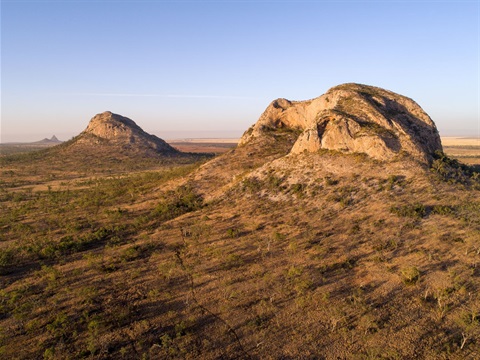The Peak Range National Park

For a scenic drive, travel along the Peak Downs Highway for panoramic views of the Peak Range National Park.
The Peak Range is a chain of prominent and picturesque mountains between Moranbah, Clermont and Dysart consisting of four sections, namely Wolfang Peak, Eastern Peak, Lord's Table Mountain and Gemini Mountains.
The sharp peaks are visible from a considerable distance across the flat country plains and are most spectacular viewed at sunrise and sunset.
The Peak Range has been built up by an extensive sequence of basalt flows and rhyolite and trachyte intrusive bodies, which erupted from the volcano between 32 and 29 million years ago.
Visitors to Peak Range National Park can enjoy bushwalking and photography, with spectacular geological features, views and historical interest.
Peak Range National Park provides a remote natural setting with no motorised vehicle access, facilities or defined walking tracks.
The National Park contains four plant species of conservation significance, including Acacia arbiana, Bertya pedicellat, Troncinia patens and Dichanthium queenslandicum.
The squatter pigeon, Geophaps scripta scripta, and the koala, Phascolarctos cinereus, are two animal species of conservation significance that have been recorded in the area.
There also has been sightings of the whip-tailed wallaby, Macrophus parryi.
Please note Walkers should prepare accordingly by referring to the Staying Safe information.
Wolfang Peak
At 572m and 172 hectares, is the most popular peak of the ranges and takes approximately an hour to summit.
It has significant scenic and geological values and climbers will discover a colony of bats in a small cave and look out for the giant St Andrew's spiders near the summit.
Once there you will experience a 360° view of the surrounding farmland and national park offering some of the most unique panoramas in Queensland.
The slope below its bare volcanic peak carries an open scrub giving way to open grassland and grassy Eucalyptus orgadophila woodland (Butler and Fensham 2008).
Peak Access: Please note this peak is under grazing lease. Access is by walking only from the Peak Downs Highway. Visitors can access the park to climb the peak via fire control lines. Queensland Parks and Wildlife Services in Clermont can provide advice on peak access and walking trails as walking trails are unmarked.
Lord's Table Mountain
Lord's Table Mountain is about 35km east of Clermont or 40km west of Dysart along the Clermont-Dysart Road.
Centrally located amongst the Peak Range National Park, the mountain itself is 320m high and flat-topped plateau, with Anvil Peak being the highest point, at the southern end.
This section compromises 761 hectares and supports the largest area of dry rainforest in the Peak Range.
It was named by Ludwig Leichhardt in 1845 and is mainly open eucalypt woodland, dry vine scrubs and mallee eucalypt at the top of the mountain.
Peak Access: Access to the mountain is via the Huntley Road.
There is a picnic table and rest area at its scenic base. Please check the condition of the Huntley Road at your local information centre, Council Office or police station prior to your trip.
Gemini Peaks
Located approximately 45km east of Clermont, the Gemini Peaks are two volcanic formations with open eucalypt woodland.
The endangered daisy Belyando Cobbler's Peg Tiocinica retroflexa found in the black soils of the park.
Peak Access: There is a basic vehicle track network for walking from the Peak Downs Highway to the foothills of the Gemini Peaks.
Eastern Peak
Approximately 50km east of Clermont and 85km north-east of Emerald, Eastern Creek is an example of a thrust dome resulting from successive intrusions and upheavals of viscous lava.
Eastern Peak is surrounded by private land and not accessible to the public.
Camping
Camping is prohibited at all peaks.
Site facilities
The Peak Range National Park and its peaks have no facilities.
Fires are strictly prohibited.
Please ensure you are environmentally conscious by removing all rubbish.
Climbing
Climbing the peaks is not recommended without advice from the local Queensland Parks and Wildlife Office.
Protective clothing and plenty of water is recommended to guard against the bush and heat.
For more information, please contact Queensland Parks and Wildlife on (07) 4983 1211.